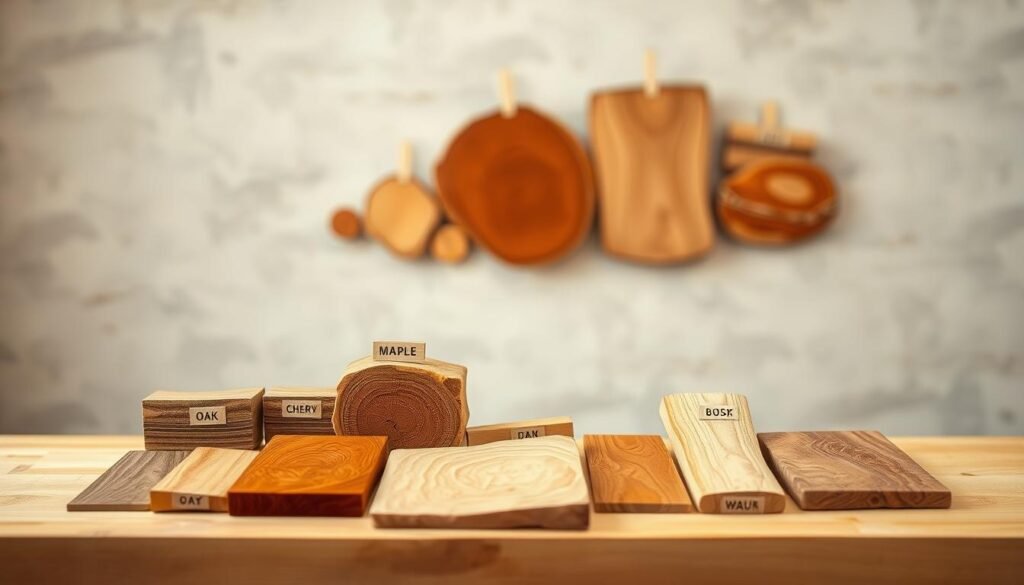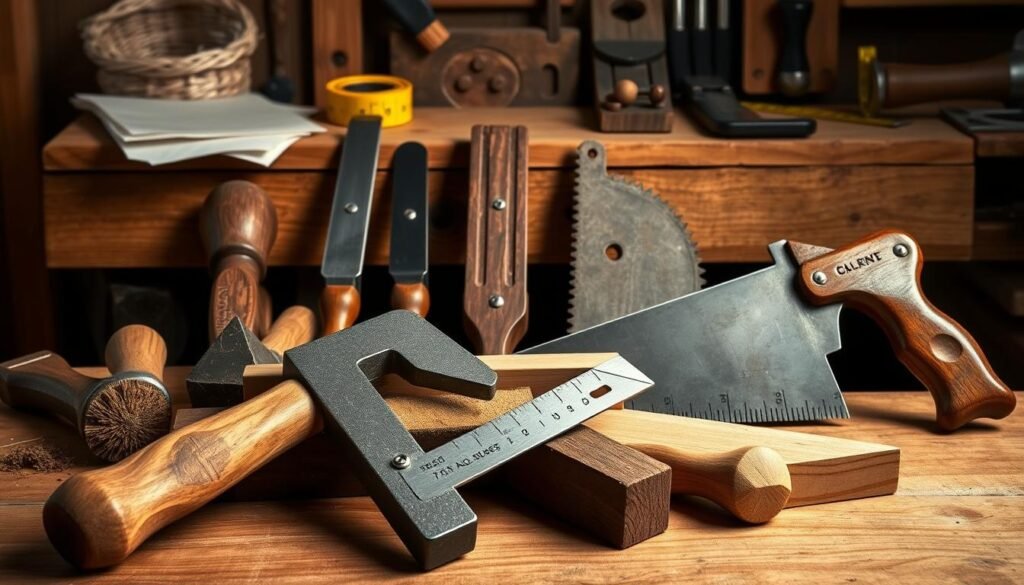Starting your woodworking journey can be thrilling yet scary. There are so many tools, techniques, and materials to learn. It’s easy to feel lost.
Woodworking is a rewarding hobby that needs patience, practice, and the right help. Knowing the basics is key to avoiding frustration and making learning easier.
This article aims to give you essential insights and tips for beginners. It covers the basic skills and knowledge you need to start.
By learning from common mistakes and best practices, beginners can set themselves up for success. They can enjoy the process of creating something with their own hands.
The Reality of Starting Your Woodworking Journey
Woodworking offers many possibilities, but starting can be tough. It’s key to get the right advice to face the first hurdles.
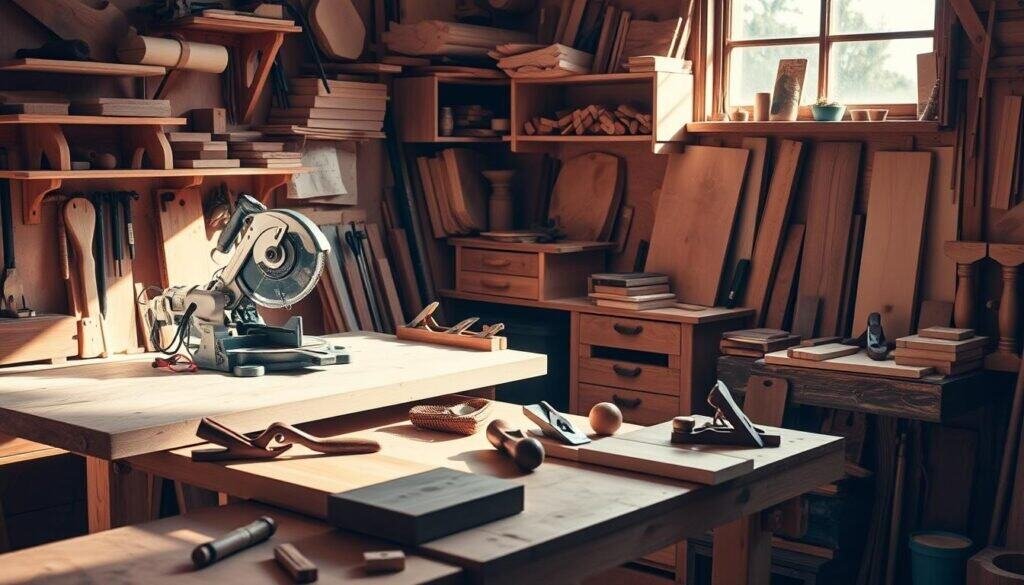
It’s normal to feel down when your projects don’t look as good as those online. Remember, skilled woodworkers have years of practice under their belts.
Setting Realistic Milestones for Skill Development
Setting goals is important to get better at woodworking. Start with easy projects and then tackle harder ones. Celebrate each step of your progress.
Common Frustrations and How to Overcome Them
Making mistakes is part of learning. Learning from these mistakes is a big part of getting better at woodworking.
Celebrating Small Victories Along the Way
It’s important to celebrate your small wins. Every project, big or small, helps you get better at woodworking.
Understanding these realities and staying positive can help beginners succeed. With the right advice, beginners can start their woodworking journey on the right foot.
Essential Tools That Won’t Break the Bank
Starting your woodworking journey doesn’t have to be expensive. As a beginner, finding the right tools without spending too much is key.
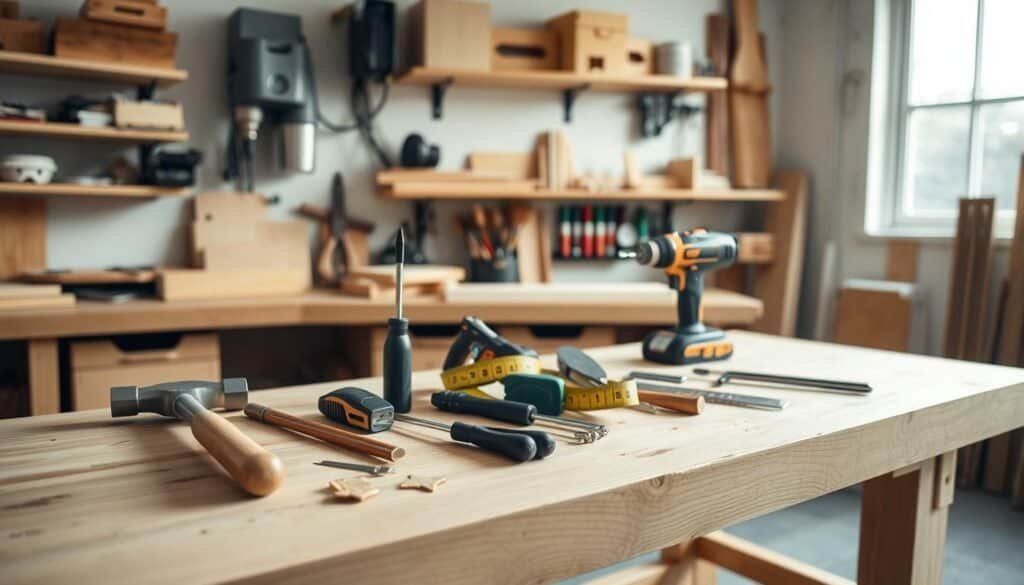
Buying quality tools that you use often is smart. A good table saw is a must for many projects. On the other hand, tools you don’t use as much can be simpler or rented.
Building Your Tool Collection Gradually
You don’t need to buy all tools at once. Start with the basics and add more as you take on bigger projects.
Multi-Purpose Tools for Maximum Value
Choosing tools that do more than one thing saves money and space. A combo router table is a great example. It’s useful for many tasks, making it a smart choice for beginners.
Rental vs. Purchase: Making Smart Decisions
Renting tools for specific projects can save money. This way, you can work on projects without a big upfront cost.
By following these tips, beginners can build a solid toolkit without spending too much. This sets them up for success in woodworking.
Setting Up Your First Workshop Space
Starting your woodworking journey means setting up a good workshop. A tidy workspace helps you do simple projects better and makes them fun.
Garage, Basement, or Shed: Optimizing What You Have
Beginners often use what they have, like a garage, basement, or shed. Make the most of your space by cleaning up and planning where to put tools and workbenches. Think about how you’ll move around and make sure there’s enough room.
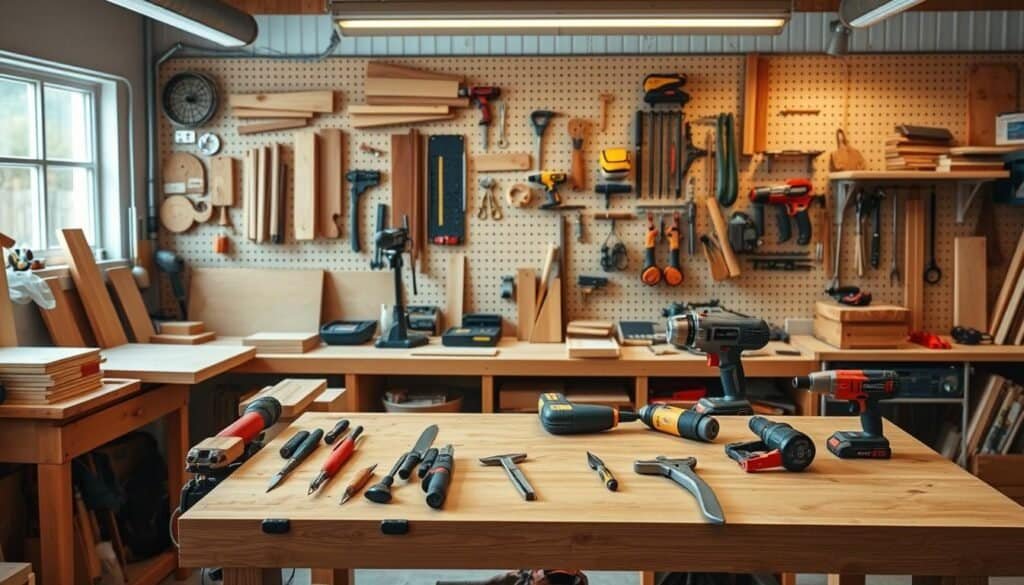
If space is tight, think about mobile workstations and fold-away tools. They let you work in a small area and then fold up to save space.
Tool Storage and Accessibility
Storing tools right is key to a neat workshop. Use wall racks, toolboxes, and labeled bins to keep things tidy. This makes it easier to work on wooden projects without getting distracted by clutter.
Dust Management for Health and Cleanliness
Keeping dust down is important for your health and a clean workshop. A dust collection system or shop vacuum can help a lot. This is very important when you’re making projects that make a lot of sawdust.
By focusing on these areas, you can make a workshop that’s both useful and enjoyable. This will help you succeed in your simple woodworking projects.
Understanding Wood: Material Selection Basics
To make beautiful and lasting woodworking projects, you need to know about wood selection. Whether you’re making small projects or planning to sell them, choosing the right wood is key.
Choosing the right wood can be tough, but starting with cheaper woods is a good idea. This way, you can practice without spending too much.
Budget-Friendly Woods for Practice Projects
For beginners, pine or poplar are great for practice. They’re cheap and let you improve your skills before using pricier woods.
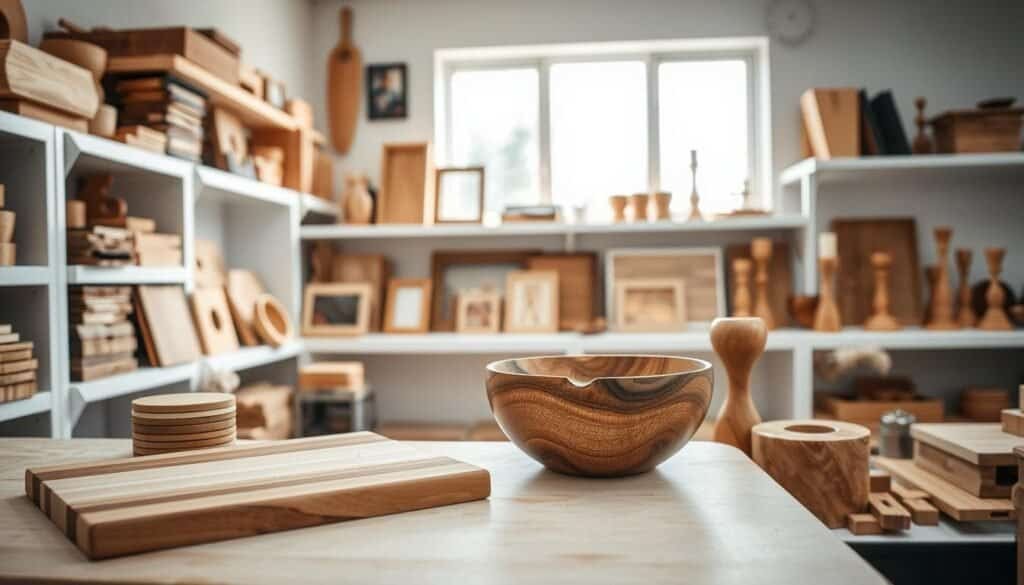
It’s important to know how wood reacts to humidity and grain direction. This knowledge helps avoid warping or cracking in your projects.
Navigating the Lumberyard or Home Center
Buying wood can be overwhelming, but knowing what to look for can help. Understanding quality and grade saves time and money.
Reading Lumber Grades and Moisture Content
Knowing how to read lumber grades and moisture content is critical. It ensures your projects last longer.
Mastering these basics will help you create successful woodworking projects. You might even sell them in the future.
Safety Practices Experienced Woodworkers Never Skip
Starting with safety is key to a great woodworking experience. It doesn’t matter if you’re doing small easy woodworking projects or bigger ones. Safety should always come first.
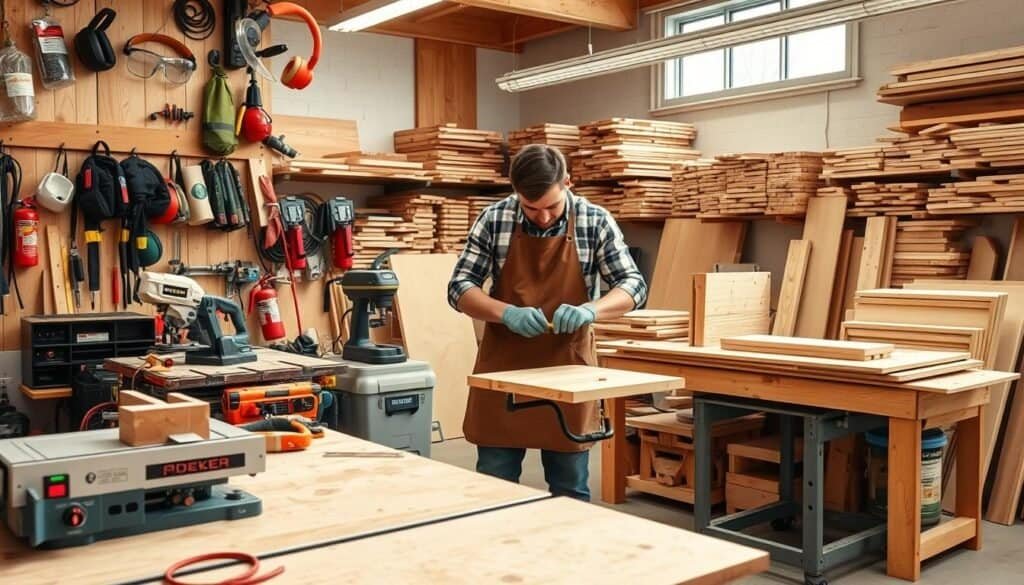
Keeping your senses safe is very important. Safety glasses or goggles protect your eyes from flying debris. Ear protection is needed to avoid hearing loss from loud tools. Also, wearing a dust mask or respirator is essential when working with wood and chemicals.
When to Upgrade Your Safety Equipment
As you get better at woodworking and start making small woodworking projects that sell, you might need better safety gear. For example, if you’re using power tools a lot, you might want to get better ear protection or a more advanced respirator.
Tool-Specific Safety Protocols
Each tool needs its own safety rules. For example, when using a table saw, always use a push stick or other safety tools to keep your hands away from the blade. Knowing and following these rules can greatly lower the chance of accidents in your woodshop projects.
Creating a Safety-First Mindset
Having a safety-first mindset is vital for all woodworkers. This means being aware of your surroundings, following safety rules, and checking your workshop for dangers. By doing this, you can make sure your woodworking space is safe and productive.
Measuring and Marking: The Foundation of Accuracy
Measuring and marking are key skills for woodworkers to ensure their projects are accurate. Whether you’re tackling wood working ideas easy or complex designs, getting your measurements right is essential.
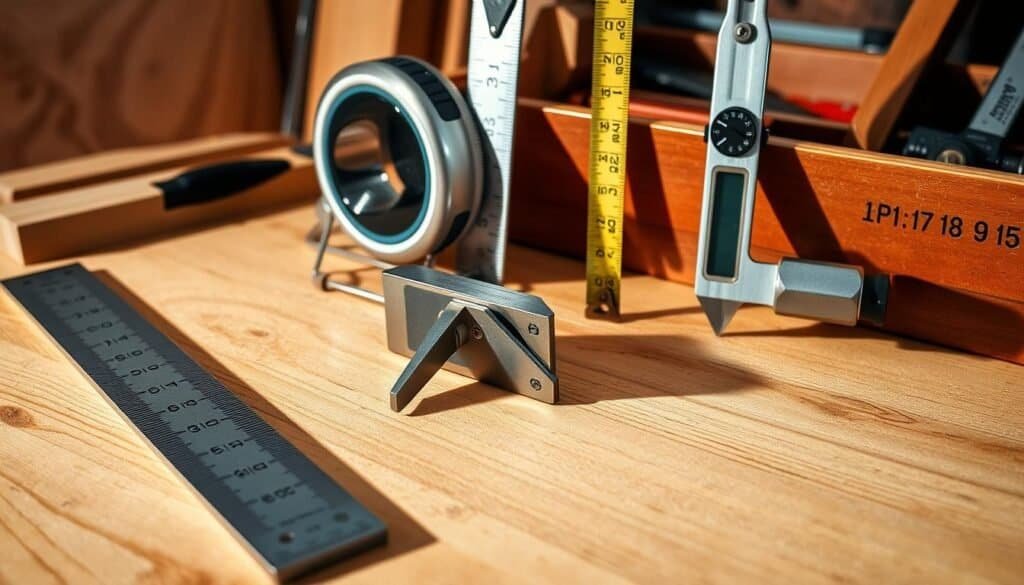
To get accurate results, you need the right tools and techniques. This means using more than just a tape measure.
Beyond the Tape Measure: Specialty Measuring Tools
Tools like calipers and micrometers offer precise measurements. They’re vital for detailed woodworking class projects. These tools help in achieving the fine details needed in professional woodworking.
Creating and Using Reference Surfaces
Creating reference surfaces ensures your measurements are consistent and accurate. This is very helpful for beginner building projects that need multiple parts to fit together perfectly.
Systematic Checking Procedures
Using systematic checking procedures helps catch errors early. This means double-checking your measurements and making sure all parts fit as planned.
Accounting for Blade Width and Material Loss
When cutting, remember to account for the blade width and material loss. This ensures your final product is the right size and you have enough material to finish the project.
Mastering measuring and marking techniques greatly improves project quality. Whether you’re new or experienced, focusing on accuracy leads to better results and more successful projects.
What Every Beginner Woodworker Wishes They Knew First About Tool Maintenance
Tool maintenance is key for any beginner woodworker. It makes tools work better and last longer. This is why it’s a smart choice for those serious about woodworking.
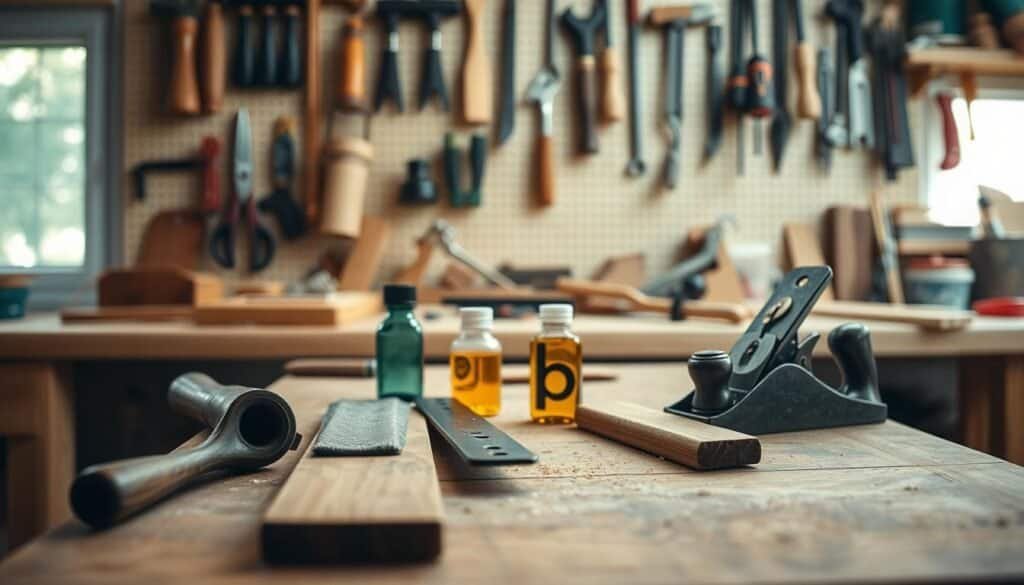
Sharpening is a basic tool maintenance skill. Beginners should learn about whetstones and sharpening steels. The goal is to get a sharp edge for clean cuts.
Recognizing When Tools Need Attention
Knowing when tools need maintenance is important. Look for dullness, rust, or misalignment. Regular checks can catch problems early and prevent bigger issues.
Cleaning and Rust Prevention Protocols
Cleaning tools and preventing rust are vital. Wipe them down, use a rust inhibitor, and store them dry. This is essential for maintaining quality in “easy woodworking projects that sell.”
Calibration and Adjustment Schedules
Regularly calibrate and adjust tools for best performance. This includes checking table saw settings and aligning chisels. For “diy wood projects for beginners,” well-maintained tools make projects more fun and rewarding.
By prioritizing tool maintenance, beginners can improve their skills. They’ll also enhance their “wood project” quality. And they’ll enjoy woodworking more.
Joinery Fundamentals Every Woodworker Should Master
Learning joinery techniques is key to making wood products that last. Joinery gives wood projects the strength they need.
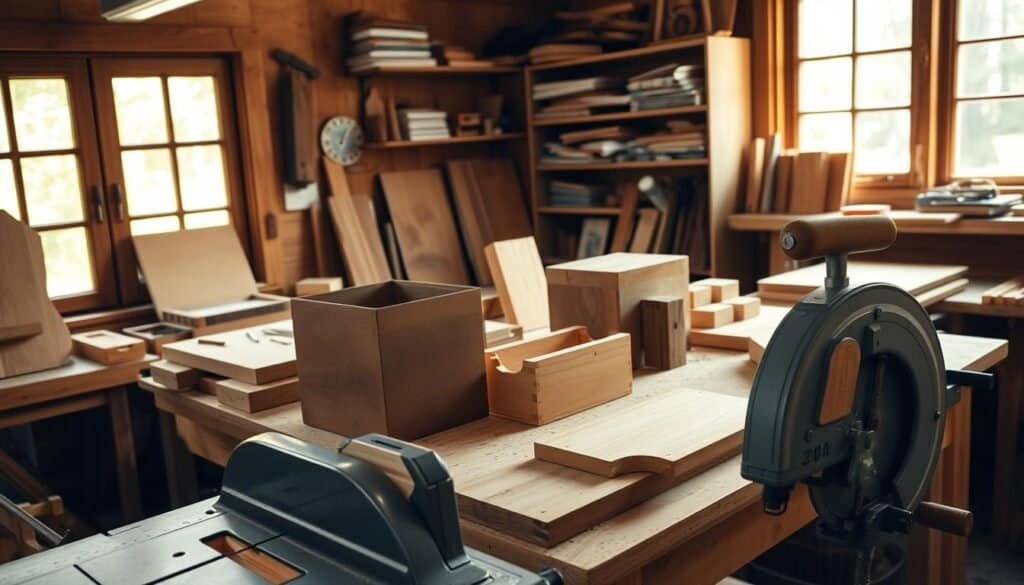
Butt joints, dados, and rabbets are basic joinery skills. Butt joints are simple for basic connections. Dados and rabbets add strength and are great for shelves and cabinets.
When to Use Mechanical Fasteners
Mechanical fasteners boost joint strength, which is important in outdoor projects. They work well with dense hardwoods.
Matching Joints to Project Requirements
The right joinery depends on the project’s needs. For example, dovetail joints are perfect for drawers. Mortise and tenon joints are better for frames.
Tools Needed for Different Joinery Methods
Each joinery method needs its own tools. Dados and rabbets often use a table saw or router. Mortise and tenon joints might need a chisel set and drill press.
Mastering these joinery basics helps woodworkers create projects that are both beautiful and strong. It brings their woodworking ideas to life.
Finishing Techniques That Transform Projects
Finishing techniques are key in woodworking, turning wood into art. The process includes several steps, each vital for a top-notch finish.
Grit Progression and When to Stop
Knowing about grit progression is key for a smooth finish. Start with coarse grit and move to finer ones. This makes the wood ready for finishing. It’s also important to know when to stop sanding, as too much can harm the wood.
Hand vs. Power Sanding Techniques
Hand and power sanding each have their uses in woodworking. Hand sanding is great for detailed work, like joints. Power sanding is better for big areas, saving time and effort.
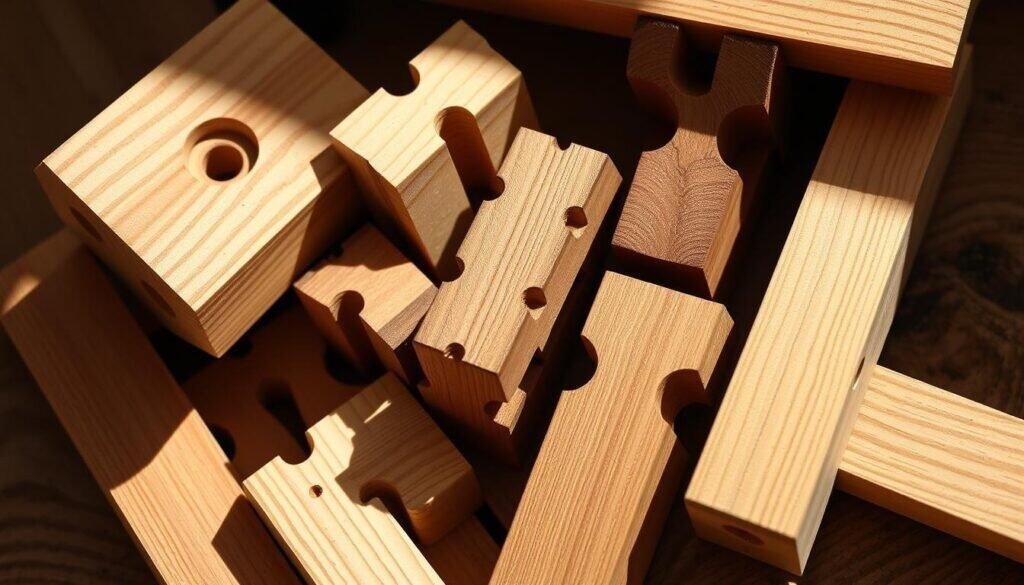
Choosing between oil and film finishes depends on the project. Oil finishes bring out the wood’s natural beauty. Film finishes offer protection. Each has its benefits, and the right choice depends on what you want.
Common Finishing Mistakes and Fixes
Even skilled woodworkers make finishing mistakes. Issues like uneven finishes and dust in the finish can happen. Knowing how to fix these is key for a perfect finish, making sure the final product looks great and lasts long.
By mastering these techniques, woodworkers can greatly improve their projects. They turn raw wood into stunning pieces that last, just like finding the perfect wood joints in the woods.
Common Mistakes That Ruin Projects (and How to Avoid Them)
As a beginner woodworker, it’s key to know the common mistakes that can make your projects frustrating. Making errors can be upsetting, but learning from them is vital. It’s a big part of the woodworking journey.
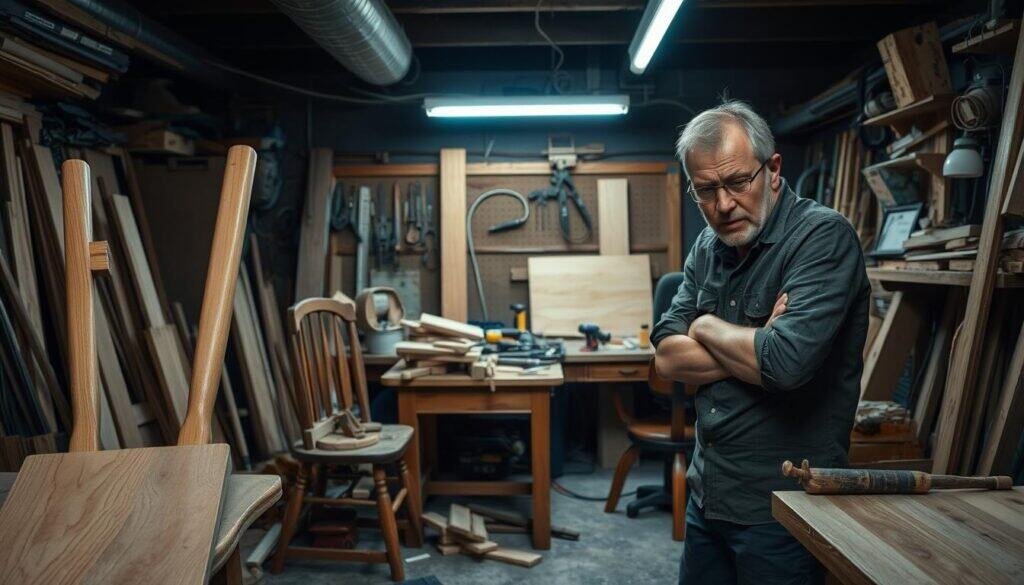
A detailed cutting list is essential for any carpentry diy project. It keeps you organized and ensures you cut the right amount of wood. This saves time and reduces waste. By making a thorough cutting list, you can dodge errors that might mess up your projects.
Accounting for Real-World Dimensions
Woodworkers often forget to account for real-world dimensions. Wood can shrink or expand with humidity changes. Not planning for this can cause joints to fit poorly. Knowing this can help you plan better for your projects.
Rushing Through Critical Steps
Rushing through important steps can cause many problems. It can lead to wrong cuts and bad joints. Taking your time and focusing on each step greatly improves your project’s quality.
Salvaging Projects When Things Go Wrong
Even with the best planning, things can go wrong. Knowing how to fix a project when mistakes happen is very useful. Whether it’s re-cutting wood or redesigning parts, being flexible can save your project from being thrown away.
By knowing these common mistakes and how to avoid them, you can make sure your projects are successful and fun. Remember, every skilled woodworker started as a beginner. Learning from mistakes is a big part of the journey.
First Projects That Build Confidence and Skills
The first projects you do in woodworking are key to your growth. Starting with fun and challenging projects boosts your confidence and skills.
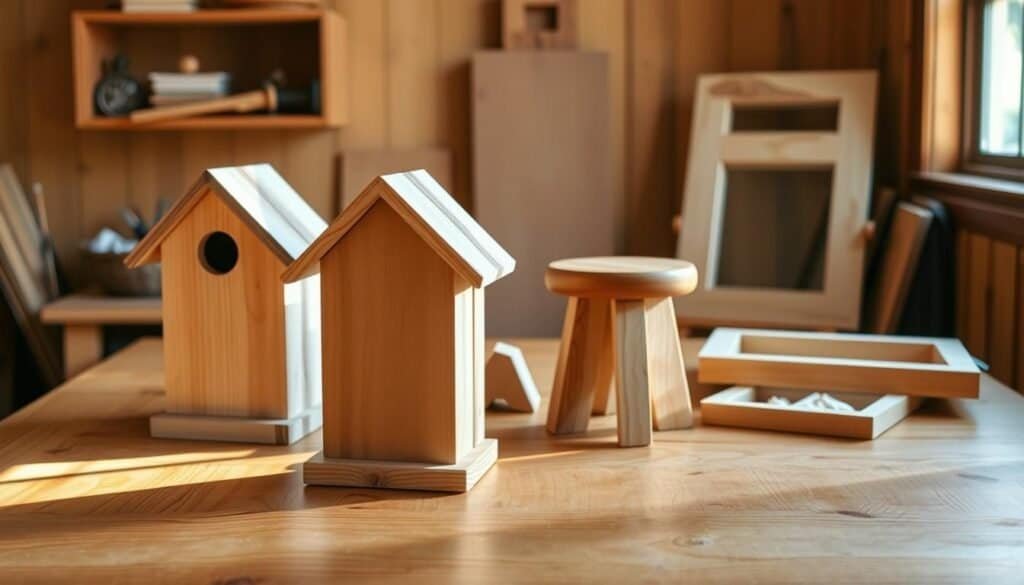
Begin with simple tasks like making cutting boards and shop accessories. These projects need little material and help you learn your tools. A cutting board, for example, teaches you how to measure and cut right.
Small Furniture Items Worth Making
When you’re good with basic tools, try making small furniture like stools, shelves, or birdhouses. These projects teach you about joinery and finishing, vital skills for woodworkers.
Skill-Building Project Sequence
Follow a project sequence to grow your skills. Start with easy projects and then tackle harder ones. This way, you avoid trying too hard too soon.
When to Challenge Yourself vs. When to Play It Safe
It’s important to know when to push yourself and when to be cautious. Use a beginner’s guide to gauge project complexity. Too much too soon can frustrate you, while being too careful might slow you down.
By picking the right first projects and following a plan, you build a solid woodworking base. Check out a beginner’s guide for more ideas and inspiration on your woodworking path.
Reading Plans and Creating Your Own Designs
Learning to read woodworking plans is a key skill for new woodworkers. It helps turn your ideas into real projects.
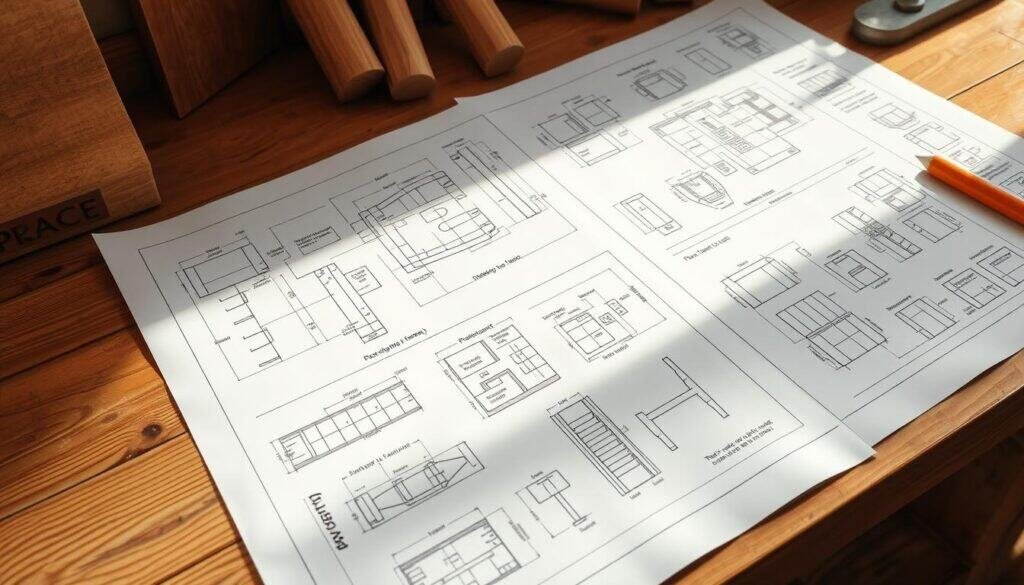
Woodworking plans use symbols and notations that can be confusing. But once you get what they mean, following plans becomes easy. Symbols show different cuts and joints.
Adapting Plans to Your Tools and Materials
Not everyone has every tool or material listed in plans. It’s important to learn to adjust plans to what you have. This means finding substitutes that work just as well.
Proportion, Balance, and Functionality
When designing, focus on proportion, balance, and function. A good design looks great and works well. Knowing these principles will make your projects better.
Sketching and Prototyping Techniques
Sketching your design and making a prototype before cutting wood is smart. It helps you refine your design and make sure it works.
By mastering these skills, beginner woodworkers can greatly improve. They’ll turn plans into beautiful, functional pieces.
The Hidden Costs of Woodworking
Woodworking is more than just making something with your hands. It comes with hidden costs that beginners need to know. Understanding these costs is key to enjoying your hobby.
When you start woodworking, you’ll find costs beyond your first tools. Ongoing expenses can add up fast.
The True Cost of Blades, Bits, and Sandpaper
Blades, bits, and sandpaper are often overlooked. They wear out and need to be replaced often. For beginners, knowing when to replace them is essential.
Planning for Tool Upgrades and Replacements
Tools, whether manual or power, have a limited life. Planning for upgrades or replacements is important. As you get better, you might need new tools for your projects.
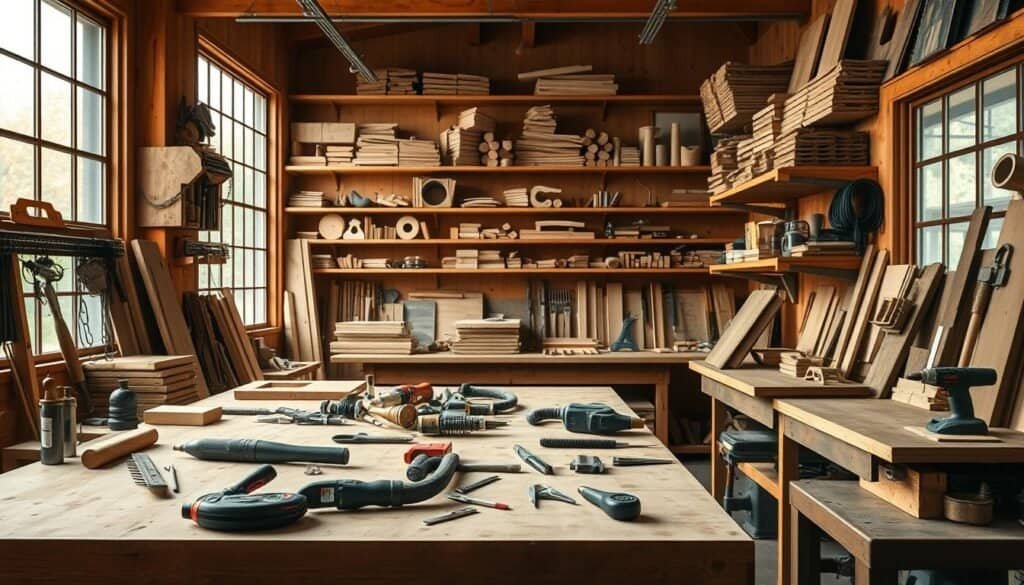
Sharing tools with other woodworkers is a smart move. It can make expensive tools more affordable. This way, you can access more equipment without breaking the bank.
Repurposing and Upcycling Materials
Using materials you already have can save money. Being creative with what you have can also add a unique touch to your projects. It shows the art and craft of woodworking.
In summary, knowing the hidden costs of woodworking helps make it more enjoyable. By managing these costs, you can focus on creating something truly special.
Sustainable and Ethical Woodworking Practices
Woodworkers love the beauty of natural wood. But, we must think about how our craft affects the environment. It’s key to follow sustainable and ethical woodworking practices to reduce our ecological footprint.
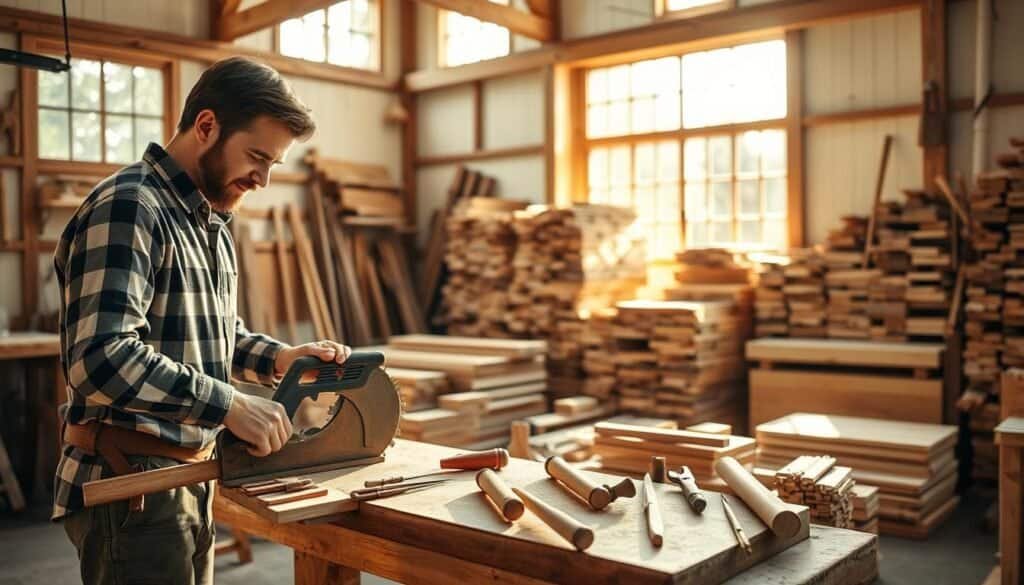
Understanding wood certification and where it comes from is vital. Look for FSC (Forest Stewardship Council) certifications. They ensure the wood is from responsibly managed forests. Knowing where your wood comes from helps you make better choices for sustainability.
Alternative and Reclaimed Materials
Using alternative and reclaimed materials is a big step towards sustainability. Think about using reclaimed wood from old buildings. Or, try materials like bamboo or locally sourced timber for your small wooden projects.
Finish and Adhesive Choices for Health and Environment
The finishes and adhesives you pick can greatly affect the environment. Choose eco-friendly options that don’t have harmful chemicals. This keeps your workspace healthy and cuts down on pollution.
Waste Reduction and Scrap Utilization
Reducing waste and using scrap wood is also important. Plan your projects well to cut down on waste. Then, find creative ways to use leftover wood for other projects to sell.
Learning Resources Beyond YouTube
Looking to grow your woodworking skills? There’s more to learn than just YouTube. Diversifying your learning can really boost your skills in diy woodworking ideas and woodshop projects.
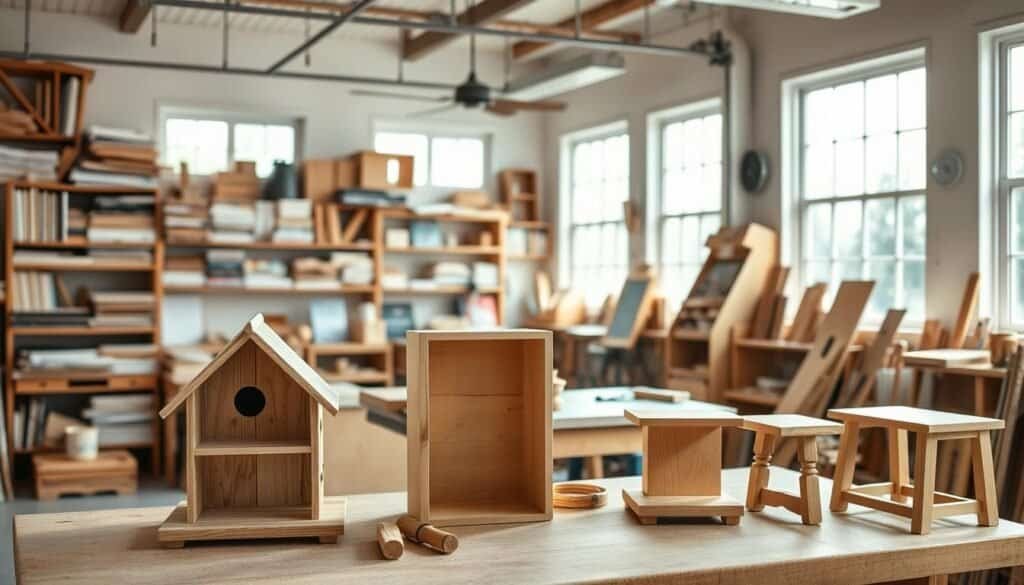
Books and magazines are key for learning woodworking. They provide detailed guides on small easy woodworking projects and advanced techniques. They suit all skill levels and styles.
Online and Local Learning Opportunities
Online courses and local workshops offer hands-on learning. They’re great for mastering specific skills like joinery and finishing. You also get to learn from experienced woodworkers.
Approaching Experienced Woodworkers for Guidance
Getting advice from seasoned woodworkers is invaluable. Join woodworking clubs or attend events to meet them. This way, you can learn from their experiences.
Collaborative Projects and Skill Exchanges
Joining collaborative projects or skill exchanges widens your woodworking knowledge. These activities improve your skills and build a community of woodworking enthusiasts.
Conclusion: Your Woodworking Journey Starts Now
Starting your woodworking journey can be thrilling and a bit scary, if you’re new. But with the right help, you can make your ideas come to life. In this article, we’ve covered key tips and techniques for beginners.
You now know how to pick the right materials and master basic joinery. You’ve also learned about keeping safe, taking care of your tools, and finishing touches that make your work stand out.
Remember, practice is essential as you start. Begin with simple projects and don’t worry about mistakes. With time and effort, you’ll get better and more confident.
Now, it’s time to bring your woodworking dreams to life. Get your tools ready, pick your materials, and start making. Woodworking offers endless possibilities, and your adventure begins today.


